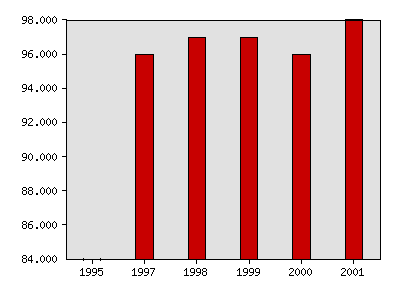What were things like in 2002?
The following idicator summary is from the 2002 Minnesota Milestones and does not neccessarily reflect the current data trends.
Indicator : Satisfaction with child care
Rationale: Research indicates that ensuring preschool children have access to high quality, stable, educational child care is an important factor in achieving this goal.
About this indicator: Parents' ratings of child care quality remain consistently high. This includes both formal child care settings and informal care from relatives, friends and neighbors. Since annual surveys began in 1997, the satisfaction level has been steady at 96 or 97 percent. In 2000 it was 98 percent. About two-thirds (68%) of Minnesota children, age 14 and younger, are in the care of someone other than their parents at least once a week.
Percentage of parents satisfied with the quality of child care (formal or informal) their children receive

Percentage of parents satisfied with the quality of child care (formal or informal) their children receive
| Year | Data |
|---|
| Percentage of parents satisfied with the quality of child care (formal or informal) their children receive, University of Minnesota, Minnesota Center for Survey Research
|
|
1995 |
84% |
|
1997 |
96% |
|
1998 |
97% |
|
1999 |
97% |
|
2000 |
96% |
|
2001 |
98% |
For comparison: No comparable survey results are available, nationwide or for other states.
Things to think about: Nearly half (45 percent) of Minnesota children age five and under are in the care of someone other than their parents for 20 hours or more per week. Two-thirds of these receive full-time care (35 or more hours a week).
Relatives are the most common caregivers for Minnesota children (29 percent) followed closely by family child care homes (23 percent) and child care centers (20 percent). Other care arrangements include informal care by a non-relative (11 percent), supervised activities (11 percent) and self-care (7 percent).
Parents using different kinds of child care have different expectations. During 1999-2000, nearly 2,500 Minnesota families participated in a study of child care use and preferences conducted by the Wilder Research Center for the Minnesota Department of Children, Families & Learning. The study found that parents relying on relatives and other informal arrangements tend to highly rate the individual attention, flexibility and stability of that type of care. Those using formal arrangements rate more highly creative activities, the caregivers' knowledge of children's needs, activities that are "just right" for their child and not watching too much TV.
Technical notes: This indicator is based on a random statewide survey of 800 families. Experts believe that parents might be reluctant to admit concerns about their children's child care in a telephone survey. For these reasons, conclusions about satisfaction levels should be treated with caution. The question asked since 1997 is, "Thinking about your children under 12, how satisfied are you with the quality of care they receive when you are not with them: very satisfied, satisfied, dissatisfied or very dissatisfied?" This is very slightly different from the question asked previously.
Sources:Minnesota Department of Children, Families & Learning, http://cfl.state.mn.us/. University of Minnesota, Minnesota Center for Survey Research, Minnesota State Survey.
Related 2002 Milestones indicator:
Local data:


Milestones is a product of the Minnesota State Demographic Center, a division of the Department of Administration






